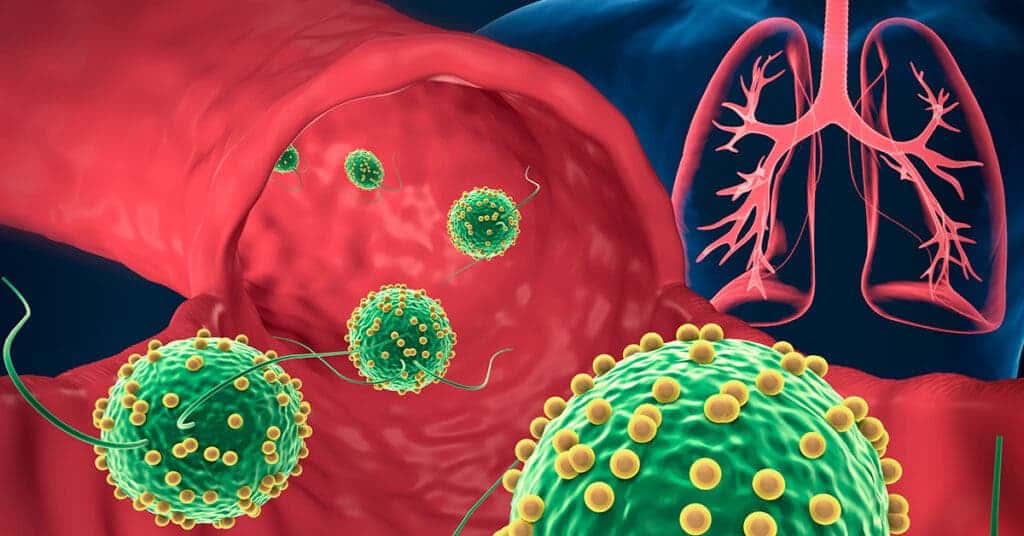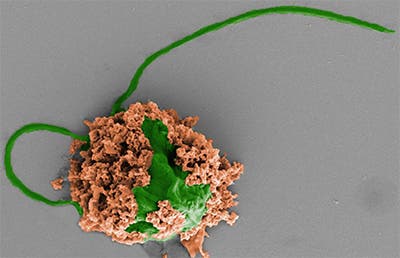Nanoengineers at the University of California San Diego are taking on pneumonia. Their solution is a swarm of microscopic robots — microrobots — that can deliver medication throughout the lungs while fighting off bacteria.

Pneumonia is a condition that affects the air sacs inside our lungs. While several different types of pathogens can lead to the development of the disease, including viruses, fungi and bacteria, all pneumonia cases are characterized by a decrease in the lungs’ ability to exchange gases with the environment. Symptoms include inflammation, chills, fevers, and coughing with a discharge of fluid or pus that builds up in the lungs’ air sacs.
Mild cases of pneumonia can go away on their own in around 1 to 3 weeks, but more severe cases can be life-threatening and require hospitalization and specialized treatment and care. Treatment options vary depending on the pathogen producing the infection.
But bacterial pneumonias now have a new and high-tech defense they need to overcome: swarms of healing microrobots.
Based on algae
“Our goal is to do targeted drug delivery into more challenging parts of the body, like the lungs. And we want to do it in a way that is safe, easy, biocompatible and long lasting,” said Liangfang Zhang, a professor of nanoengineering at UC San Diego and corresponding author of the paper. “That is what we’ve demonstrated in this work.”
During laboratory trials using mouse models, the microrobots proved themselves efficient at clearing pneumonia-causing bacteria from the lungs, resulting in a 100% survival rate of mice treated this way. All animals in the control group, which were injected with the same bacterial strain but did not receive treatment with the robots, died within three days of infection.
Each robot is constructed from an algae cell with antibiotic-filled nanoparticles affixed to its surface. The living algae cell provides motility (the ability to move) to the microrobot so that it can travel throughout the lung and come into direct contact with as many bacteria as possible. Meanwhile, the nanoparticles on their surface take the shape of biodegradable spheres that are coated with the cellular membranes of human neutrophils, a type of immune cell. These membranes absorb and neutralize the inflammatory compounds produced both by the bacteria and our bodies’ immune systems. By reducing excess inflammation, the team explains, these microrobots can help improve the speed with which the infection is cleared out.

The microrobots were developed in a joint effort between the labs of nanoengineering professors Joseph Wang and Liangfang Zhang at UC San Diego. Wang specializes in micro- and nanorobotics, while Zhang’s expertise lies in the development of cell-mimicking nanoparticles for treating infections and diseases — and both are leading experts in their fields.
This team has worked on drug-delivering microrobots before, finding the best approaches to allowing these devices to be safely used in living animals. Previously, they focused on bacterial infections in the stomach and blood, and the lungs are their latest objective.
In order to study the efficacy of their new microrobots, the team infected lab mice with Pseudomonas aeruginosa, a bacterium that causes an acute and potentially fatal form of pneumonia. This is commonly seen in patients who receive mechanical ventilation in intensive care units around the world.
The robots were administered to the mice using a tube inserted through their windpipe that reached the lungs. All of the mice treated this way had their infections completely clear in one week’s time and survived over 30 days after the fact.
The robots were more effective at clearing out the infection than the regular approach of antibiotic injections, the team explains. Furthermore, injections would require an antibiotic dose 3000 times higher than that used by the robots when dealing with the same infection. The authors explain that a dose of microbots provided around 500 nanograms of antibiotics per mouse, while an IV injection would provide 1.644 milligrams of antibiotics per mouse (one milligram is one million nanograms).
Such a high-efficiency rate in the use of the antibiotic compounds is owed to the microrobots’ ability to take it directly to the site of infection, rather than having it spread out through the body.
“These results show how targeted drug delivery combined with active movement from the microalgae improves therapeutic efficacy,” said Wang.
“With an IV injection, sometimes only a very small fraction of antibiotics will get into the lungs. That’s why many current antibiotic treatments for pneumonia don’t work as well as needed, leading to very high mortality rates in the sickest patients,” said Victor Nizet, co-author on the study. “Based on these mouse data, we see that the microrobots could potentially improve antibiotic penetration to kill bacterial pathogens and save more patients’ lives.”
Apart from the impressive results, the study also showcased that the use of algae-based microrobots is also safe, causing no side effects. After treatment, these cells are consumed by our immune system alongside any remaining nanoparticles, leaving behind no toxic waste.
Despite this, the research is still solidly in its proof-of-concept stage. Much more work is required to fully understand how such microrobots would interact with a human immune system and to determine what it can and cannot do in detail. More and larger-scale animal trials will need to be performed before the microrobots get a chance to prove themselves in human trials — and only then could we potentially talk about such a treatment becoming commercially available.
The paper “Nanoparticle-modified microrobots for in vivo antibiotic delivery to treat acute bacterial pneumonia” has been published in the journal Nature Materials.


